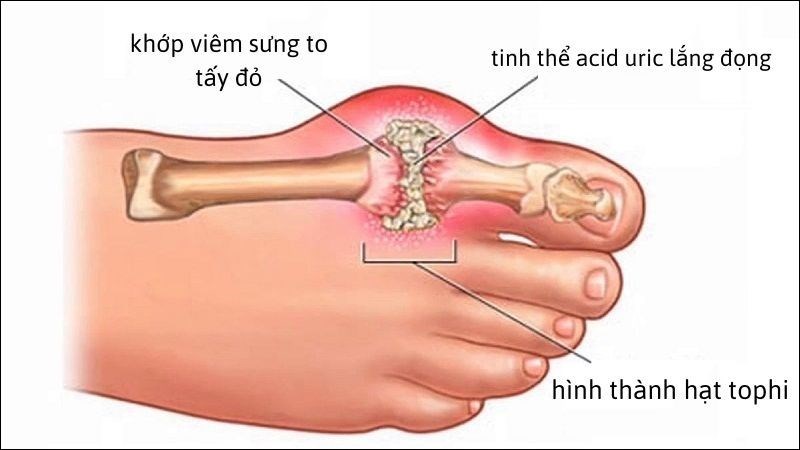
Gout
Gout
Is Gout a “Rich Man’s Disease”?
Causes of Gout
Gout (also known as gouty arthritis) is one of the most painful forms of arthritis. It results from a disruption in the natural breakdown of purines, leading to an excess of uric acid in the blood, which accumulates as urate crystals in the joints, causing inflammation. These microscopic urate crystals deposit in the synovial membrane, leading to joint swelling and pain. Additionally, urate deposits can occur in other areas, such as tendons, bursae, the pericardium, myocardium, heart valves, skin, nails, and feet.
Gout is categorized into two types: primary gout and secondary gout.
- Primary Gout: Linked to genetic factors and the body’s natural purine metabolism.
- Secondary Gout: Caused by dietary and lifestyle habits, such as excessive consumption of foods and beverages like liver, organ meats, red meat, fish, mushrooms, shrimp, crab, alcohol, beer, and carbonated soft drinks.
In other words, primary gout is hereditary, while secondary gout results from an imbalanced diet and unhealthy lifestyle.

Traditional Medicine Perspective on Gout
In traditional medicine, gout is referred to as thống phong (painful wind disease). It is believed to result from external pathogens invading the body, blocking the meridians, and causing stagnation of blood and energy (khí trệ huyết ứ), leading to joint swelling, pain, and restricted movement. The disease initially affects the muscles and meridians before progressing to the tendons and bones, eventually damaging internal organs. The dysfunction of khí huyết (vital energy and blood) and tân dịch (body fluids) leads to the accumulation of dampness and phlegm, forming nodules around the joints and under the skin. If left untreated, gout can cause long-term damage to the liver, spleen, and kidneys.
Gout is classified into two main types in traditional medicine:
- Wind-Damp-Heat Syndrome (Acute Gout Attacks): Characterized by severe joint pain, redness, swelling, and heat in the affected areas.
- Phlegm-Damp Stagnation Syndrome (Chronic Gout): Marked by persistent joint pain, stiffness, and the formation of tophi nodules around joints and under the skin.

Common Symptoms of Gout
- Severe Joint Pain: Sudden, intense pain, swelling, redness, and heat in one or more joints, commonly the big toe.
- Chronic Progression: Many patients mistakenly believe they are cured once the pain subsides, but the disease continues to progress silently. If left untreated, flare-ups become more frequent and severe.
- Tophi Formation: In later stages, tophi (urate crystal deposits) form around joints, leading to joint deformities, disability, and aesthetic concerns.
- Complications: Advanced gout can cause joint destruction, kidney dysfunction, liver damage, lipid metabolism disorders, diabetes, and high blood pressure.
Challenges of Treating Gout with Western Medicine
Doctors typically prescribe anti-inflammatory drugs, pain relievers, and uric acid-lowering medications to manage gout. While these medications provide immediate relief, they often come with significant side effects. Unsupervised use of these drugs can lead to severe complications.
Common Western Medications for Gout:
- Uric Acid-Reducing Drugs:
- Allopurinol – reduces uric acid production.
- Probenecid – increases uric acid excretion via the kidneys.
- Anti-Inflammatory and Pain Relievers:
- Colchicine, Corticosteroids – used for acute gout attacks.
- Alkalizing Agents:
- Sodium bicarbonate solutions, Foncitril – help neutralize uric acid and improve its elimination.

Traditional Medicine Approach to Gout Treatment
Wind-Damp-Heat Syndrome (Acute Gout Attacks)
Symptoms:
- Sudden onset of intense pain in the big toe and foot joints.
- Severe swelling, redness, and sensitivity— even the slightest touch causes extreme pain.
- Additional symptoms: fever, headache, dry mouth, thirst, fatigue, and loss of appetite.
Phlegm-Damp Stagnation Syndrome (Chronic Gout)
Symptoms:
- Enlarged, stiff joints with difficulty in movement.
- Tophi nodules form in painful joints, under the skin, and around the ear cartilage.
- Nodules feel soft and are usually painless.
- Often seen in overweight individuals with a swollen tongue and teeth imprints on the tongue’s edges.
Traditional Japanese Medicine for Gout
Traditional medicine focuses on balancing khí huyết (energy and blood), cooling the body, and detoxifying accumulated uric acid. Some commonly used methods include:
/https://cms-prod.s3-sgn09.fptcloud.com/nang_mui_kieng_hai_san_bao_lau_nen_an_gi_trong_24_gio_sau_nang_mui_1_7f53e9f67a.jpg)
Herbal Remedies:
- Angelica Root (Angelica sinensis): Improves blood circulation and relieves pain.
- Cibotium Root (Cibotium barometz): Strengthens the joints and reduces inflammation.
- Szechuan Lovage Root (Ligusticum chuanxiong): Used in combination with other herbs to reduce swelling and pain.
- Atractylodes (Atractylodes macrocephala): Enhances digestion and reduces toxin accumulation.
Other beneficial herbs include Bupleurum, Ginger, Jujube, Scutellaria, Peony, Pinellia, Citrus Aurantium, and Rhubarb.
Acupuncture:
Acupuncture can help relieve pain and inflammation by stimulating specific points associated with joint health and uric acid metabolism.
Massage and Reflexology:
Gentle massage of affected areas improves blood circulation and helps relieve pain.
Dietary Recommendations for Gout Management
Foods to Include:
- Alkaline Vegetables: Cucumber, okra, pennywort, coriander, lettuce, spinach, kale, watercress, bitter herbs, and artichokes.
- Fruits: Papaya, bananas, watermelon, cantaloupe, custard apple.
- Hydration: Herbal teas like artichoke tea, cat’s whiskers tea, phyllanthus tea, and chrysanthemum tea.
- Carbohydrates: Brown rice, whole wheat bread, corn, fresh root vegetables.
- Healthy Fats: Sesame oil, olive oil.
- Proteins: Dairy products (milk, cheese, yogurt) and certain fish like snakehead fish, perch, and bream.
Foods to Avoid:
- High-Purine Meats: Organ meats, red meats, game meats.
- Seafood: Sardines, anchovies, mackerel, tuna, squid, shrimp, crab.
- Spices: Excessive pepper, chili, garlic, curry, fish sauce.
- Beverages: Alcohol, coffee, strong tea, chocolate, cocoa.
Gout Prevention Tips
- Maintain a Healthy Weight: Obesity increases uric acid levels and gout attacks.
- Reduce or Eliminate Alcohol and Sugary Drinks: Alcohol increases lactic acid, which competes with uric acid for elimination, leading to its buildup.
- Stay Hydrated: Drink at least 2-3 liters of water daily to help flush out uric acid through urine.
- Limit High-Purine Foods: Avoid anchovies, sardines, goose meat, and organ meats.
- Increase Vegetable and Plant-Based Protein Intake: Consume plenty of greens, fruits, and plant-based proteins.
Try Kanpo 210 to support gout management and improve joint health using traditional Japanese medicine!
